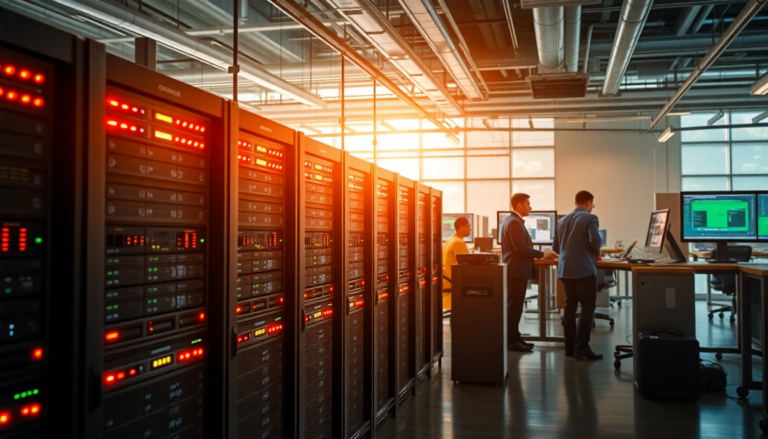Argomenti trattati
In the bustling world of tech, where innovation drives the economy, Oracle’s recent move to purchase around 400,000 Nvidia GB200 AI chips for a staggering $40 billion has sent shockwaves through the industry. This isn’t just a purchase; it’s a strategic maneuver that positions Oracle at the forefront of the AI revolution, particularly with the U.S. Stargate project, a colossal $500 billion initiative aimed at expanding AI infrastructure across the nation. As I reflect on the fervor of the tech race, this investment feels like a significant turning point, reminiscent of the gold rush days when selling shovels was the real money-maker.
The U.S. Stargate project: A new chapter in AI infrastructure
Set to be developed in Abilene, Texas, the Stargate project is not merely another data center; it aims to deliver a jaw-dropping 1.2 gigawatts of computing power, making it one of the most powerful facilities globally. This ambitious endeavor is backed by heavyweight investors, including Oracle, OpenAI, SoftBank, and the Abu Dhabi sovereign wealth fund MGX. It’s fascinating to think about how these colossal investments will reshape the AI landscape. I remember when tech giants were just beginning to dabble in AI; now, it feels as if we’re on the brink of a new technological era.
The complexities of ownership and development
Interestingly, the ownership dynamics surrounding the Abilene site add a layer of complexity to this narrative. The land is owned by Cruso, an AI infrastructure company, and Blue Owl Capital, a U.S. investment firm, both of whom have collectively invested over $15 billion into this project. The construction, which began last June, spans approximately 875 acres and includes eight buildings. Oracle’s lease agreement for 15 years signals a long-term commitment to harnessing this power to support its AI ambitions.
What’s particularly striking is how Oracle plans to lease this computing power to OpenAI, enabling the latter to train its next-generation AI language models. This shift indicates a departure from OpenAI’s previous reliance on Microsoft’s data centers, which became insufficient to meet its growing demands. This evolution raises the question: what does this mean for partnerships in the tech industry moving forward?
A shift in partnerships and strategies
The decision to terminate the exclusive contract with Microsoft marks a pivotal moment for OpenAI. As many know, partnerships are often the lifeblood of tech innovation, but sometimes, they can become shackles. OpenAI’s frustrations with its former provider led to a broader strategy to seek out new collaborations for its processing power needs. This decision could lead to a more competitive environment, with other tech firms scrambling to secure their own AI capabilities.
Moreover, the recent announcements surrounding Stargate UAE, where OpenAI plans to deploy a 1GB cluster in Abu Dhabi, show that the appetite for advanced AI infrastructure is insatiable. G42’s plans to build a 5 GW data center using over 2 million Nvidia GB200 chips further underline the urgency of this tech race. It’s almost as if we’re witnessing a modern-day arms race, but instead of missiles, the weapon of choice is computational power.
Nvidia’s rise to prominence
The ripple effects of these developments have significantly boosted Nvidia’s status in the tech world. As recently reported by a study, Nvidia has emerged as one of the most valuable companies globally, reclaiming its top position in late 2024. The demand for powerful AI chips has skyrocketed, with Oracle’s $40 billion order being just one example of this trend. Meanwhile, Elon Musk is reportedly raising funds for Colossus 2, which will feature a million GPUs, showcasing the fierce competition among tech giants.
But let’s not ignore the broader implications of these investments. The surge in demand for cutting-edge AI chips suggests a future where AI’s capabilities will expand exponentially. It raises the question of whether we’re prepared for such a rapid advancement of technology. Personally, I believe that with great power comes great responsibility, and as these technologies evolve, so must our ethical considerations.
Looking ahead: The future of AI infrastructure
In this whirlwind of investments and partnerships, it’s challenging to anticipate where the landscape will be in just a few years. The Stargate project could redefine how we think about AI infrastructure, making it more accessible and powerful than ever before. As I ponder the future, I can’t help but feel a mix of excitement and apprehension about the pace of technological advancement. What will this mean for businesses, consumers, and even society at large? The implications are vast and, frankly, a bit daunting.
As tech enthusiasts, we find ourselves at a crossroads of innovation and ethical considerations. The race for AI supremacy is on, and it’s a thrilling time to be involved in technology. However, it’s crucial that we remain vigilant and thoughtful about the direction in which we are heading. After all, in this fast-paced world, it’s easy to forget the human element behind the technology we create.

